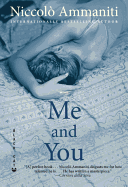
| Publisher: | Black Cat | |
| Genre: | Fiction, Literary | |
| ISBN: | 9780802170903 | |
| Pub Date: | February 2012 | |
| Price: | $14 |
| Fiction |
by Niccolo Ammaniti, trans. by Kylee Doust
As Niccolò Ammaniti begins his very short novel, it's 10 years later, and Lorenzo is a young man sitting by himself in a restaurant in a little town, staring down at a cup of coffee and about to re-read a short letter written 10 years earlier by his half-sister, Olivia.
The context of the letter is the basis of the novel. How the lives of Lorenzo and Olivia converge and change each other, each one filling the gaping hole in the other's life, creates a touching alliance, providing a brief respite from the alienation of their lives. As Lorenzo pieces together the tragic past and miserable present of his half-sister, the two reach out and almost heal each other.
This is the third novel by Ammaniti to be translated since his brilliant little masterpiece, I'm Not Scared, became an international sensation and a popular foreign film. In Me and You, Ammaniti's spare style becomes so lean the tale is hardly more than a short story, but don't discount it for its brevity. It's a literary experience that packs an enormous emotional wallop. --Nick DiMartino, Nick's Picks, University Book Store, Seattle
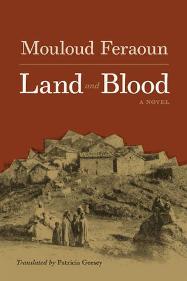
| Publisher: | University of Virginia Press | |
| Genre: | Fiction, Literary | |
| ISBN: | 9780813932217 | |
| Pub Date: | February 2012 | |
| Price: | $22.50 |
| Fiction |
by Mouloud Feraoun, trans. by Patricia Geesey
Mouloud Feraoun, a friend of Albert Camus, was murdered by right-wing paramilitary terrorists in 1962 during the last days of French colonial rule in Algeria. His 1953 novel, Land and Blood, takes place in the 1930s in the Algerian village of Ighil-Nezman, in a corner of Kabylia.
Amer is a prodigal son returning after 15 years to the village where he was born. With him is his beautiful wife, Marie, a poor Parisian starting a new life. The Kabyles are a poverty-stricken people; many of the men go to France to work in the coal mines, where Amer caused the death of his uncle in a mining accident. Marie is that uncle's suspected love-child. The man's brother is waiting for Amer in his home village, planning vengeance.
This ancient village is thick with secrets, and Feraoun reveals them one by one: wives who have covered for impotent husbands with secret lovers, husbands who have sidestepped infertile wives with convenient cousins, the land-swapping, the power alliances. The villagers are wary of a couple with no children. Amer and his French wife are childless; so are the dead man's brother and his young wife, Chabha. Four childless people, with an unresolved murder between them.
Feraoun lyrically reveals the intricacies of Kabylian life. Part anthropological re-creation of a lost way of life, part tragic love story of a village nearly ripped apart by ancient codes of honor and conflicting allegiances, Land and Blood is a dense, richly rewarding novel memorializing a little-known world in transition. --Nick DiMartino
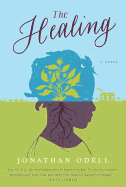
| Publisher: | Doubleday | |
| Genre: | Fiction, Cultural Heritage, Coming of Age, Historical, African American | |
| ISBN: | 9780385534673 | |
| Pub Date: | February 2012 | |
| Price: | $26 |
| Fiction |
by Jonathan Odell
In the pre-Civil War South, Master Ben Satterfield's plantation has been ravaged by cholera. He refused to have his daughter treated for a "slave disease," so she died, and his opium-addicted wife, Amanda, will make him pay for this for the rest of his life. On the day her daughter dies, she takes a newborn slave from her mother, names the girl Granada and keeps her as another pet (alongside a monkey named Daniel Webster).
For $5,000, Master Ben buys a woman named Polly Shine, reputed to be a healer. Polly is a force of nature, who singles out Granada to live with her in the "hospital" Ben has built, insisting that the young girl has "the gift." Granada doesn't want any part of Polly or her hospital, being perfectly happy to dress in silk and enjoy special privileges. Her wishes are not considered; she becomes Polly's shadow, learning to keep still, watch and listen.
Granada, 70 years later, is Gran Gran, recounting past history to calm an abandoned child who has been brought to her care. Gran Gran recalls the influence Polly had on the plantation and its occupants. She does, indeed, heal bodies and souls; insists on improved housing and diet for the slaves; and aids at the births of more "stock" for Master Ben. That isn't all she does, though, and the way she accomplishes her ends is at once horrifying, compelling and too clever for words.
Jonathan Odell finds the right words, using the language of the day, its idiom and its music to great advantage in a compelling work that can stand up to The Help in the pantheon of Southern literature. --Valerie Ryan, Cannon Beach Book Company, Ore.
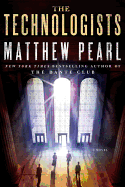
| Publisher: | Random House | |
| Genre: | General, Suspense, Fiction, Thrillers, Historical, Literary | |
| ISBN: | 9781400066575 | |
| Pub Date: | February 2012 | |
| Price: | $26 |
| Mystery & Thriller |
by Matthew Pearl
After The Dante Club, The Poe Shadow and The Last Dickens, Matthew Pearl gives us a historical thriller without a writer's name in the title: The Technologists is set in 19th-century Boston, and the author draws readers into another stylish mystery surrounded with some real people and grounded in fact.
Early April morning, 1868, in foggy Boston Harbor, compasses on ships go crazy with disastrous results. Directionless vessels strike others, crash into piers. Many boats sink and passengers are injured. A day later in downtown Boston, the "windows of the buildings suddenly come alive," and the melting glass leads to death. The police, baffled, turn to renowned scientist Louis Agassiz for help.
Professor Agassiz is not the star of Pearl's story, though. That distinction belongs to a group of students at Boston's newest university, the Massachusetts Institute of Technology. As local citizens wonder if the college's scientifically inclined students might be behind the disasters, four students, led by Marcus Mansfield, create a society dedicated to solving the mystery with science: the Technologists. They discover a chest in Boston Harbor that may have contributed to the first disaster, then come across a lab that may have been used by the person who caused the second catastrophe. And when the case heats up, and Marcus is kidnapped, could the faculty of Harvard Medical School be involved?
It all may sound rather melodramatic--it is, but in Pearl's hands, the story threads come together in a quite believable manner. He sets the post-Civil War scene effectively, with labor unions worried about being replaced by machines and religious activists who have their own concerns about scientific progress. The Technologists is a vintage period mystery-thriller, and good fun. --Tom Lavoie, former publisher
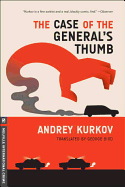
| Publisher: | Melville House | |
| Genre: | Fiction, Mystery & Detective, Hard-Boiled | |
| ISBN: | 9781612190600 | |
| Pub Date: | February 2012 | |
| Price: | $14.95 |
| Starred | Mystery & Thriller |
by Andrey Kurkov, trans. by George Bird
It's 1997, and a retired general has risen up into the sky over Kiev, hung from a huge Coca-Cola balloon. The corpse vanishes from the forensics lab, only to reappear--missing the right thumb. Though the murder of this important government official warrants a full team of investigators, it's assigned to Viktor Slutsky, a mere lieutenant whose usual case load consists of petty street crimes. The narrative flips back and forth between Viktor and Nik Tsensky, a young interpreter trying to earn enough money for his wife and son to join him in Kiev. Nik is hired by a mysterious colonel to rescue a man from an arranged fake attempt on his life--a man disconcertingly dressed just like Nik.
The bodies pile up rapidly, one of them in Viktor's car. Both protagonists receive mysterious orders over the telephone as the plot thickens, and everyone seems to know more about what's happening in The Case of the General's Thumb than the hapless pair.
So what does the general's thumb have to do with all this? You won't find out till the very end. For Kurkov, the ending is less important than the fun of leading us through a world of deaf blondes driving hearses and revolvers that fire backwards, where bugs are planted in the walls and security cameras trained on the doors. Kurkov employs a subtle magic that pulls you in until you realize you're actually starting to care about these helpless, violent men trapped by economic circumstances into a grim dance of death. --Nick DiMartino, Nick's Picks, University Book Store, Seattle
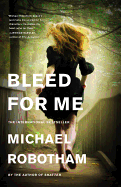
| Publisher: | Mulholland Books | |
| Genre: | Fiction, Psychological, Thrillers | |
| ISBN: | 9780316126380 | |
| Pub Date: | February 2012 | |
| Price: | $25.99 |
| Mystery & Thriller |
by Michael Robotham
Joe O'Loughlin is a semi-retired psychologist struggling to hold his marriage and family together while coping with Parkinson's disease. After moving from London to a quiet small town to find some peace, Joe is trying to teach part-time at the local university, make up with his wife and be a good father to his teenage daughter, Charlie. But then Charlie's best friend Sienna shows up one night covered in blood. She can't remember what happened, but her father, a decorated ex-cop, has been murdered and it's his blood on her hands. Joe is reluctantly talked into helping out with the investigation.
The mystery begins with the murder of Sienna's father, but it quickly gets more complicated, until Joe is investigating decades-old crimes, a neo-Nazi gang and a schoolteacher's past--all while trying to understand Sienna's wounded psyche. Of course, he's also still trying to patch things up with his wife and Charlie.
Bleed for Me, Michael Robotham's fourth novel featuring Joe O'Loughlin, is fast-paced, disturbing, gritty and complex, with a highly charismatic narrator and hero. As the well-meaning and earnest Joe turns rogue investigator, puts his own life at risk and battles Parkinson's all at the same time, he easily earns the reader's compassion. His unlikely friends (including a bitter but loving ex-cop) make for surprising moments of humor, and the suspense keeps the reader ducking surprise blows. --Julia Jenkins, librarian and blogger at Pages of Julia
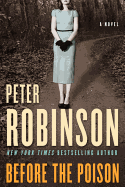
| Publisher: | Morrow | |
| Genre: | Fiction, Thrillers | |
| ISBN: | 9780062004796 | |
| Pub Date: | February 2012 | |
| Price: | $25.99 |
| Mystery & Thriller |
by Peter Robinson
Before the Poison starts, very simply, with the purchase of a house. After 25 years abroad, successful Hollywood musician Chris Lowndes has decided to return to the Yorkshire countryside of his youth. He purchases Kilnsgate House sight unseen, trusting his real estate agent to handle the transaction. Upon arriving at the house, however, Chris discovers that its former owner, Ernest Fox, was poisoned to death in his bedroom nearly 50 years earlier; his wife, Grace Fox, was found guilty of his murder and sentenced to hang. Chris is quickly captivated by this story of domestic distress and execution; convinced of Grace's innocence, he sets out to learn what really happened all those years ago--and finds a story of romance and war he never would have expected.
Peter Robinson, best known for his police procedural series featuring Inspector Alan Banks, recounts the hidden story of Kilnsgate House through imagined histories, letters and diary entries of the 1950s, interspersed with Chris's first-person narration of events. Though the style results in somewhat uneven characters, it ultimately succeeds in providing important insights into the thoughts and actions of both Grace Fox and Chris Lowndes.
These insights carry the reader through Grace's often harrowing experiences as a wartime nurse and Chris's efforts to cope with his own wife's death to a well-imagined, if somewhat tidy, conclusion. The result is an intriguing mystery that draws on the classic trope of the haunted old country house, but does so in such a way that it feels newly invented. --Kerry McHugh, blogger at Entomology of a Bookworm

| Publisher: | Avery | |
| Genre: | Cooking, Courses & Dishes, Desserts, Vegetarian & Vegan | |
| ISBN: | 9781583334638 | |
| Pub Date: | February 2012 | |
| Price: | $27.50 |
| Food & Wine |
by Doron Petersan
Don't be deterred by the word "vegan" in the subtitle: Sticky Fingers' Sweets is a delightful, user-friendly cookbook for anyone with a sweet tooth who also hopes to become a healthier and more compassionate baker. Doron Petersan begins by analyzing the science of baking and explains how "mixing, temperature, moisture, air, and chemical leavening agents work together to form the structure and texture of your treats." Can't imagine baking without eggs? "The secret to the egg is in its chemical and nutritional makeup," Petersan explains. "Eggs are not the only ingredients that contain these magic components or achieve these results." Fortunately, the replacement ingredients and techniques are easy to find and execute.
Beyond the fascinating peek into the science of vegan baking, Petersan provides many recipes from her 10 years at her Washington, D.C., bakery Sticky Fingers Sweets & Eats, including the recipe she used to win the Food Network's Cupcake Wars. These recipes all come with simple-to-follow directions and ingredients common to most kitchens, making the book a lovely gift for anyone new to the world of baking.
In addition, reading Sticky Fingers' Sweets is like having Petersan sitting at the counter with you. Throughout, she includes "Love Bites"--fun facts that extoll the health benefits of the ingredients--and the chatty accounts of her first whoopee pie or why anisette reminds her of her grandmother are amusing and engaging, yet never detract from the heart and soul of this cookbook: delicious, accessible recipes that do not harm animals. --Kristen Galles from Book Club Classics
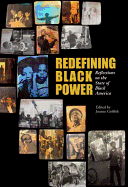
| Publisher: | City Lights | |
| Genre: | Political Science, Biography & Autobiography, Cultural Heritage, Ethnic Studies, Social Science, Political Freedom & Security, African American Studies - General, Civil Rights | |
| ISBN: | 9780872865464 | |
| Pub Date: | February 2012 | |
| Price: | $16.95 |
| Political Science |
by Joanne Griffith, editor
The 2008 election of Barack Obama as president was a watershed moment for many African-Americans, including those who thought such an event unimaginable in their lifetimes. Redefining Black Power, a collection of interviews conducted by Joanne Griffith, considers the extent to which Obama's rise to the White House was a true game changer that helped to redress the political status quo in the U.S.--or else window dressing for a political system that has been known to disenfranchise its poorest whether they are of color or not.
Griffith's stellar introduction places Obama's rise in the historical context of previous generations' struggles for equality and a seat at the table of American power, recounting the emotional heft she and other African-Americans felt at Obama's victory. The interviews that follow are never less than fascinating; they are lively, engaging give-and-takes on the Civil Rights Movement, poverty and under-employment in America and on Obama's place in history. Assessments range from Ramona Africa's view of Obama as a cold careerist--too beholden to the people who elected him and to his own desire to retain power--to Dr. Vincent Harding's more empathetic view, seeing Obama as a force of cohesion for various groups long marginalized by the American political system.
This book displays a full, rich range of responses from America's black intelligentsia, cultural icons, artists and activists who at times question the meaning and the motives of the president rather than simply assume he offers a panacea for issues that have plagued this country since its inception. --Donald Powell, freelance writer
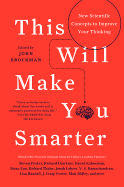
| Publisher: | Harper Perennial | |
| Genre: | General, Medical, Neuroscience, Science | |
| ISBN: | 9780062109392 | |
| Pub Date: | February 2012 | |
| Price: | $15.99 |
| Science |
by John Brockman, editor
Some contributors believe that a "cognitive toolkit" should incorporate the scientific method to educate our minds to think critically and rationally, overcoming bias and uncertainty and encouraging experimentation in the context of everyday life. Others, like biologist P.Z. Myers, advocate an acceptance of human mediocrity and a recognition that life occurs as a consequence of natural circumstances. J. Craig Ventner stresses the need for humans to accept they are not the center of the universe. For Kathryn Schulz, the realization that human truths today become falsehoods tomorrow should force us to consider contradictory viewpoints. Neuroscientist Robert A. Provine gets his universal truth from Robert A. Heinlein's TANSTAAFL: "There ain't no such thing as a free lunch."
Brockman's collection demonstrates that our futures depend on our abilities to take classroom lessons that can stretch the limits of intellectual capabilities and apply them to the patterns of life. The principles of lifelong learning and social conscientiousness his panel of experts advocate would do much in improving everybody's cognitive toolkit. --Nancy Powell, freelance writer
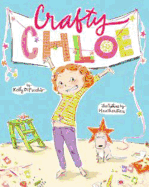
| Publisher: | Atheneum | |
| Genre: | Girls & Women, Friendship, Holidays & Celebrations, Social Issues, Juvenile Fiction, Birthdays | |
| ISBN: | 9781442421233 | |
| Pub Date: | February 2012 | |
| Price: | $16.99 |
| Children's & Young Adult |
by Kelly S. DiPucchio, illust. by Heather Ross
In this uplifting picture book, Kelly DiPucchio (Zombie in Love) and Heather Ross (Weekend Sewing) prove that a gift made by hand often has more heart.
Chloe may not be good at sports or video games, but she is "very good at making stuff." A series of funny vignettes shows her resourceful use of "Dad's old shirts" (though it looks like he still finds at least one of them current) and coffee filters (much to the dismay of a sleepy mom in dire need of coffee). Chloe's dog serves as fashion model for her skills as a seamstress. While she reaches for a doll to buy as a birthday gift for her best friend, Emma, classmate London gets to it first. Chloe shrugs it off. "I'm going to make her something special," she tells London. But what?
DiPucchio and Ross's approach shows examples of Chloe's inventiveness in ways that invite young readers to try their hands at the crafts. We see Chloe's blueprint and "ingredients" (markers, a box of patterns, glitter and glue) for her projects. And though DiPucchio and Ross depict doodling as a way into her project ("Doodling helps her think"), they don't give away Chloe's gift for Emma until the very end. When London trips on her sparkly heels on the way to Emma's party and nearly ruins her gift, Chloe helps her out. Author and artist model excellence and kindness without ever getting preachy. --Jennifer M. Brown, children's editor, Shelf Awareness
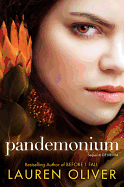
| Publisher: | HarperCollins | |
| Genre: | General, Love & Romance, Science Fiction, Social Issues, Juvenile Fiction | |
| ISBN: | 9780061978067 | |
| Pub Date: | February 2012 | |
| Price: | $17.99 |
| Children's & Young Adult |
by Lauren Oliver
In this sequel to her heart-wrenching Delirium, Lauren Oliver (Before I Fall) will leave readers applauding the daring routes Lena travels in a dystopian, loveless America.
Here Lena leaves her old self "behind a wall of smoke and flame," having escaped from Portland, Maine, where she saw Alex--the boy who "infected" her with amor deliria nervosa, love--shot down at the border. Reeling with grief, Lena is reborn in the unregulated territory of the Wilds. Raven, a leader of the rebellion against the DFA (Deliria-Free America), rescues Lena and enlists her in their cause. Lena agrees, in honor of Alex's memory ("He believed in the resistance, and now I will believe in it for him").
Raven teaches Lena to forget the past ("There is no before. There is only now, and what comes next"), and prepares her to infiltrate the DFA in order to observe 18-year-old Julian Fineman, son of the DFA's founder. Julian has not undergone the cure because of previous surgeries to correct a recurring brain tumor. But he is daring to "excise the sickness" of love, even if it kills him. On Julian's cure day, chaos ensues in Times Square, Lena and Julian end up imprisoned together, and they form a bond.
Pandemonium alternates between "Then" and "Now" chapters, the action spaced six months apart. Oliver cuts back and forth seamlessly, and creates a mystery around Raven's past and the reason she's assigned Lena to Julian. The tension and twists leading up to the end of this volume will certainly build anticipation for the trilogy's finale. --Adam Silvera, assistant coordinator, Books of Wonder, New York